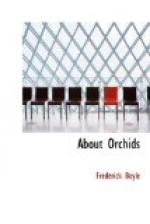ORCHIDS.
There is no room to deal with this great subject historically, scientifically, or even practically, in the space of a chapter. I am an enthusiast, and I hold some strong views, but this is not the place to urge them. It is my purpose to ramble on, following thoughts as they arise, yet with a definite aim. The skilled reader will find nothing to criticize, I hope, and the indifferent, something to amuse.
Those amiable theorists who believe that the resources of Nature, if they be rightly searched, are able to supply every wholesome want the fancy of man conceives, have a striking instance in the case of orchids. At the beginning of this century, the science of floriculture, so far as it went, was at least as advanced as now. Under many disadvantages which we escape—the hot-air flue especially, and imperfect means of ventilation—our fore-fathers grew the plants known to them quite as well as we do. Many tricks have been discovered since, but for lasting success assuredly our systems are no improvement. Men interested in such matters began to long for fresh fields, and they knew where to look. Linnaeus had told them something of exotic orchids in 1763, though his knowledge was gained through dried specimens and drawings. One bulb, indeed—we spare the name—showed life on arrival, had been planted, and had flowered thirty years before, as Mr. Castle shows. Thus horticulturists became aware, just when the information was most welcome, that a large family of plants unknown awaited their attention; plants quite new, of strangest form, of mysterious habits, and beauty incomparable. Their notions were vague as yet, but the fascination of the subject grew from year to year. Whilst several hundred species were described in books, the number in cultivation, including all those gathered by Sir Joseph Banks, and our native kinds, was only fifty. Kew boasted no more than one hundred and eighteen in 1813; amateurs still watched in timid and breathless hope.




